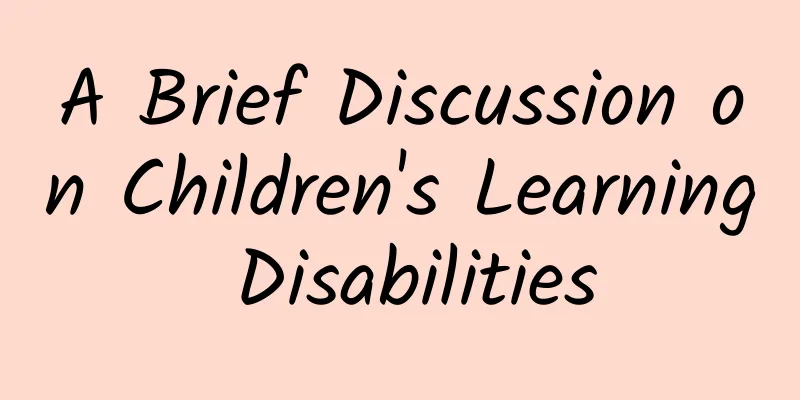A Brief Discussion on Children's Learning Disabilities

|
Some parents are confused as to why their children do not study as well as other children or have learning difficulties. Some parents are anxious and blame their children for being stupid, some parents think their children are not working hard enough, and some parents blame each other... Based on relevant research results at home and abroad, let's see who should be blamed. A Genetic Blame Clinical observations and epidemiological surveys have found that learning disabilities tend to run in families. Genetic factors can alter the normal development of language expression; more direct evidence comes from gene linkage analysis, where sex chromosome inheritance can cause an imbalance in language and motor skills and developmental delay. The structure and function of the 2 nerves The occurrence of language disorders is related to the left hemisphere of the brain, while visual-spatial disorders are related to abnormalities in the right hemisphere. The main causes of dyslexia are: abnormalities in the structure and functional lateralization of the two hemispheres of the brain. Specifically, children with dyslexia have increased white matter in the left hemisphere, dislocation and heterogeneity of parietal cortical cells, and a small left temporal lobe. The maturation process of the brain is delayed, resulting in delayed acquisition of developmental skills, so that the immaturity of the cerebral hemisphere function (rather than substantial damage or defects) leads to learning disabilities. Psychomotor ability Psychomotor movement refers to the fine movements performed by the individual's consciousness, which is mainly manifested in the proper coordination of various senses and movements. Those who can make appropriate movements at the appropriate time and space have a high degree of psychomotor ability. Children with learning disabilities show abnormalities in the motor effects and motor response centers controlled by the brain, such as decreased memory, decreased attention, visual perception, visual spatial coordination and movement accuracy in the search function of specific attention, decreased wrist flexibility and hand reaction ability. Children with these defects are easily distracted by external interference, have poor concentration, cannot listen carefully, have slow reaction speed, uncoordinated movements, cannot concentrate on homework, and are often careless and sloppy during exams, so it is difficult for them to achieve good results. Learning adaptability Learning adaptability is a comprehensive behavioral process, and its influencing factors come from both the outside and, more importantly, the inside of the human body. Adaptive learning means being able to treat learning correctly, having good learning motivation and learning ability, mastering appropriate learning methods and learning techniques, having the willpower to overcome various difficulties in the learning process, and achieving better learning results. Therefore, learning adaptability requires good personality factors of the individual to maintain. Children with a high level of learning adaptability show obvious high stability, persistence, daring, experimentality and self-discipline in personality characteristics, as well as low excitability, sensitivity, suspicion and tension. Life adaptation is one of the components of mental health. Learning adaptation is essentially a kind of life adaptation, and therefore has a close relationship with the level of mental health. Those with good learning adaptability generally have lower levels of psychological problems and symptoms than children with poor learning adaptability. Five grievances intelligence Intelligence can be seen as the ability to accumulate knowledge and experience to adapt to real life or complete learning and work tasks. It is a comprehensive cognitive ability, including a person's psychological activities of acceptance, preservation, understanding, thinking, and use in cognition. Although the intelligence of children with learning disabilities is within the normal range, it is still an important factor affecting children's academic performance. Unbalanced intelligence structure is an important factor causing children's learning difficulties. In terms of intelligence structure, verbal IQ is lower than operational IQ, and there are obvious memory and attention defects, among which verbal comprehension and analytical comprehensive ability are particularly poor. Among the general intelligence factors of children with learning disabilities, the indirect abstract thinking ability - analogical reasoning ability is relatively poor. On the one hand, they have defects in indirect abstract thinking ability, and on the other hand, it may be due to the long-term learning difficulties of these children, which affects the acquisition of knowledge and hinders the development of intelligence. Six resentful emotions and behaviors Children with learning disabilities have more emotional and behavioral problems, such as psychosomatic problems, impulsive and hyperactive behaviors, and these problems may continue into adolescence and adulthood. People with learning disabilities have higher levels of trait anxiety or state anxiety than those without learning disabilities. They have more physical complaints, sleep disorders, excessive worry or underestimation of their abilities, and anxiety levels are positively correlated with sleep problems. The incidence of depression in people with learning disabilities is higher than in the general population. In early childhood, attention problems often coexist with learning disabilities, and about one-third of children with learning disabilities have attention deficits; in late childhood, juvenile delinquency is an important indicator of antisocial behavior, and academic failure is strongly linked to juvenile delinquency. Low IQ, parental psychopathy, and improper parenting methods are the three main factors that contribute to juvenile crime. Seven Grudges Family Democratic education is conducive to children's growth, while negative and indulgent education can easily make children develop unhealthy psychology such as interpersonal sensitivity, depression, and anxiety. If parents often use punishment as a means to treat their children harshly, their children often have no sense of security, become neurotic, sensitive, suspicious, and lonely; excessive interference and protection will make children lack confidence, lack of initiative, inferiority and irritability; long-term rejection and denial will induce children's high anxiety, inferiority and hostility, and they cannot correctly understand themselves; family members are not harmonious, and communication is incomplete, which can easily form children's sense of incompleteness, insecurity, inferiority and paranoia, and high anxiety levels. Parents with a high level of education are often easy to communicate with their children, and can correctly intervene and guide children to enable children to meet adults' expectations of them. They are extremely cautious in using negative methods such as punishment, severe attitude, rejection and denial; while parents with low education levels often use simple, rough and closed education methods. Eight Complaints School Teachers' words and deeds are often authoritative in the eyes of children, and they become role models or idols for children. The quality of school spirit and the relationship between classmates also directly or indirectly affect children's learning. Too much homework, too frequent exams, lack of understanding between teachers and students, and children's belief that teachers decide their attitudes based on their grades all have an impact on children's learning. In addition, children in schools with good educational quality and children living in areas with good atmosphere have significantly fewer behavioral problems than those in the opposite situation. Nine Complaints about Society Changes in values, the loss of control of traditional moral norms, the weakening of political beliefs and interests, the lack of scientific theory education, and the negative effects of communication media have all had varying degrees of impact on children's learning. As can be seen from the above, children's learning disabilities are far from being as simple as some parents think. They involve internal factors, external factors, and psychological cognitive factors, which are interrelated and influence each other, and are intricate. Finding the crux of children with learning disabilities and formulating targeted intervention measures is the key to solving children's learning disabilities. |
<<: 50 yuan to buy a hamster, 1,000 yuan to inject serum, why do hamsters bite people?
Recommend
What causes vulvar itching after menstruation?
Women often experience vulvar itching after menst...
What to do if hormone levels are low in early pregnancy
I believe that many people must know about the is...
What happens if blood clots are discharged during abortion?
Although abortion is a common surgery, it can cau...
Are skin care products with pure natural ingredients safer?
Not absolutely. When it comes to choosing skin ca...
Is scanty menstruation really an endocrine disorder?
Normal women have a menstrual cycle every month, ...
HPV vaccine in Beijing
What are the side effects of the HPV vaccine? The...
What are the nursing care for pregnancy-induced hypertension?
Nowadays, many pregnant women suffer from gestati...
What is the difference between soybean sprouts and mung bean sprouts? Does soybean sprouts have a high purine content?
Soybean sprouts and mung bean sprouts are made fr...
What is normal blood sugar during pregnancy?
Regardless of whether they suffer from gestationa...
How to massage vaginal care
Women should not neglect the maintenance of their...
What are estrogen and progesterone drugs?
As the name suggests, estrogen drugs are a type o...
A 34-year-old foreign man often suffers from visual fatigue due to high hyperopia
"I really don't want to wear glasses any...
Is it normal to have dark blood clots during menstruation?
Menstruation is the shedding of the endometrium f...
Why is there heavy bleeding after sex?
A good sex life can increase the affection betwee...









